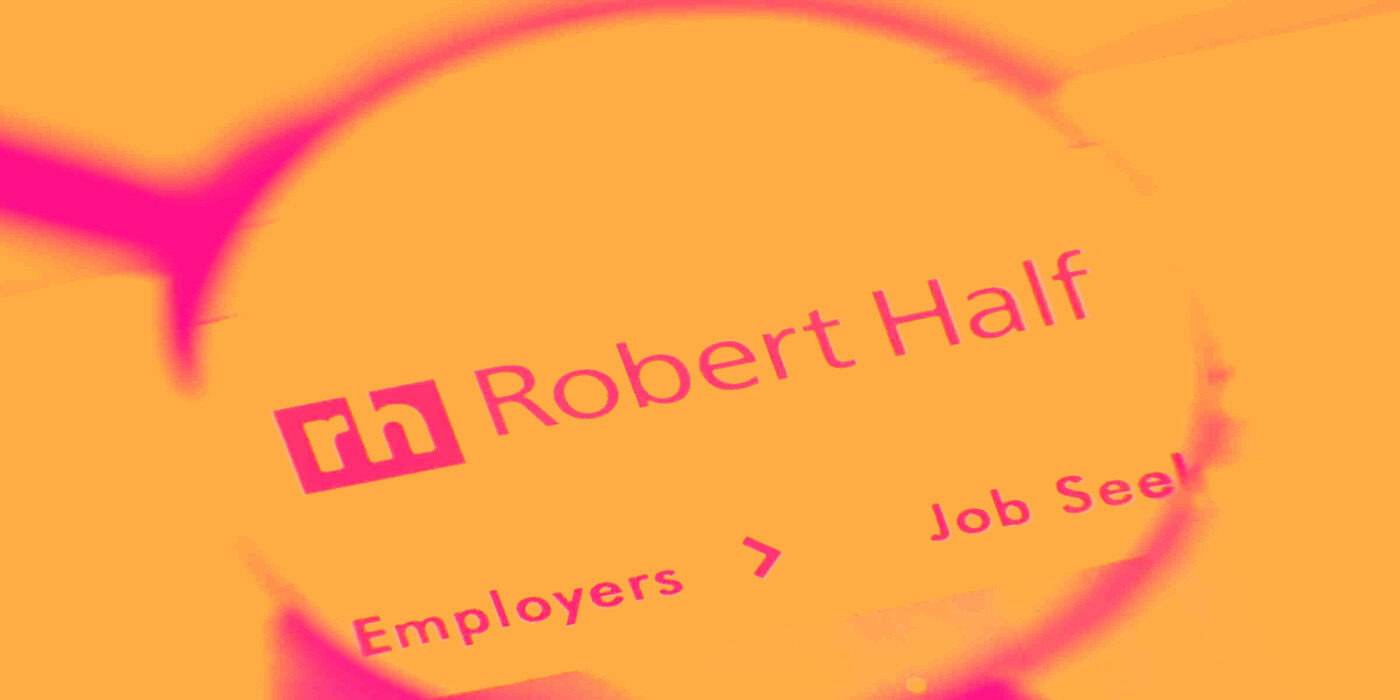
Specialized talent solutions company Robert Half (NYSE: RHI) met Wall Street’s revenue expectations in Q3 CY2025, but sales fell by 7.5% year on year to $1.35 billion. Its non-GAAP profit of $0.43 per share was in line with analysts’ consensus estimates.
Is now the time to buy RHI? Find out in our full research report (it’s free for active Edge members).
Robert Half (RHI) Q3 CY2025 Highlights:
- Revenue: $1.35 billion vs analyst estimates of $1.36 billion (7.5% year-on-year decline, in line)
- Adjusted EPS: $0.43 vs analyst estimates of $0.43 (in line)
- Adjusted EBITDA: $73.49 million vs analyst estimates of $76.75 million (5.4% margin, 4.2% miss)
- Operating Margin: 1%, down from 4.1% in the same quarter last year
- Market Capitalization: $2.96 billion
StockStory’s Take
Robert Half’s third quarter results were met with a negative market response, as ongoing softness in hiring activity and subdued new project starts continued to weigh on the company. Management cited client and job seeker caution as primary factors limiting growth. CEO Keith Waddell described the environment as one where “overall hiring and quit rates remain low, [but] job openings continue to trend well above historical averages,” pointing to persistent uncertainty among clients and candidates. While the company saw sequential improvement in contract talent revenues towards the end of the quarter, the overall backdrop for professional staffing and consulting remained challenging.
Looking forward, management’s guidance reflects cautious optimism, with expectations for a return to sequential revenue growth for the first time in over three years. Keith Waddell emphasized early signs of improvement, noting that “rising client and candidate confidence fuels additional hiring and project activity.” However, the company continues to anticipate pressure on margins due to shorter billing periods and a shift in project mix, particularly within its Protiviti consulting segment. The leadership team remains focused on leveraging technology and higher-skill placements to drive future efficiency and profitability, while acknowledging that a full recovery will depend on broader macroeconomic trends and client demand normalization.
Key Insights from Management’s Remarks
Management attributed the quarter’s performance to persistent hiring caution, evolving project mix, and distinct trends between its staffing and consulting segments.
-
Client and job seeker caution: Management highlighted that both clients and candidates remained hesitant to make hiring decisions, leading to subdued activity across staffing and consulting. Waddell noted that compensation and work flexibility were not sufficient to entice candidates to change roles, especially in permanent placement.
-
Contract talent trends stabilized: Weekly revenue trends in contract talent sustained second quarter levels and began to grow sequentially in September and October. Waddell said, “We’re encouraged by the weekly trends and contract talent revenues, which began to grow sequentially in September and into October.”
-
Protiviti project mix shift: The Protiviti consulting segment continued to face margin pressure as large, efficient projects were replaced by a higher number of smaller, less profitable engagements. Management explained that this shift, alongside a deliberate strategy to keep full-time staff fully deployed—even in contractor roles—impacted overall gross margins.
-
Persistent margin compression: Both Talent Solutions and Protiviti saw higher SG&A (selling, general, and administrative) costs as a percentage of revenue, driven by fixed cost deleverage due to fewer billing days and lower volumes. Waddell stated, “You’re going to lever your fixed cost less, which for Protiviti means gross margin...for Talent Solutions is SG&A.”
-
Dividend and capital allocation focus: Despite lower free cash flow, the company reaffirmed its commitment to maintaining its dividend, supported by its cash reserves. Management indicated that share repurchases will remain limited in favor of preserving the dividend, given the current business cycle.
Drivers of Future Performance
Management expects gradual improvement ahead, but near-term performance will depend on client demand, project mix, and ongoing cost discipline.
-
Sequential revenue growth potential: Management forecasts a return to positive sequential revenue growth for the first time in over three years, supported by improving weekly trends in contract talent and rising small business hiring plans. However, they caution that this trend remains fragile and contingent on a broader uptick in client and candidate confidence.
-
Margin headwinds from project mix: The continued shift in Protiviti’s project portfolio toward smaller, shorter-duration assignments is expected to weigh on gross and operating margins, with management targeting only gradual improvement. SG&A deleverage from fewer billing days and persistent fixed costs will also create headwinds.
-
Technology and skill mix investments: The company is prioritizing higher-skill placements and ongoing technology enhancements, including AI-enabled recruiter tools, to increase productivity and efficiency. Management believes these investments will support margin expansion when demand recovers, with a long-term goal of returning Protiviti to double-digit operating margins.
Catalysts in Upcoming Quarters
In the coming quarters, the StockStory team will focus on (1) whether sequential growth in contract talent and permanent placement revenues can be sustained, (2) progress toward improving Protiviti’s project mix and gross margins, and (3) the company’s ability to control SG&A costs despite ongoing market uncertainty. How quickly clients resume hiring and project launches, as well as further adoption of technology-driven staffing solutions, will also be key indicators of recovery.
Robert Half currently trades at $28.94, down from $29.64 just before the earnings. In the wake of this quarter, is it a buy or sell? See for yourself in our full research report (it’s free for active Edge members).
Now Could Be The Perfect Time To Invest In These Stocks
When Trump unveiled his aggressive tariff plan in April 2025, markets tanked as investors feared a full-blown trade war. But those who panicked and sold missed the subsequent rebound that’s already erased most losses.
Don’t let fear keep you from great opportunities and take a look at Top 5 Growth Stocks for this month. This is a curated list of our High Quality stocks that have generated a market-beating return of 183% over the last five years (as of March 31st 2025).
Stocks that made our list in 2020 include now familiar names such as Nvidia (+1,545% between March 2020 and March 2025) as well as under-the-radar businesses like the once-micro-cap company Kadant (+351% five-year return). Find your next big winner with StockStory today.
StockStory is growing and hiring equity analyst and marketing roles. Are you a 0 to 1 builder passionate about the markets and AI? See the open roles here.





